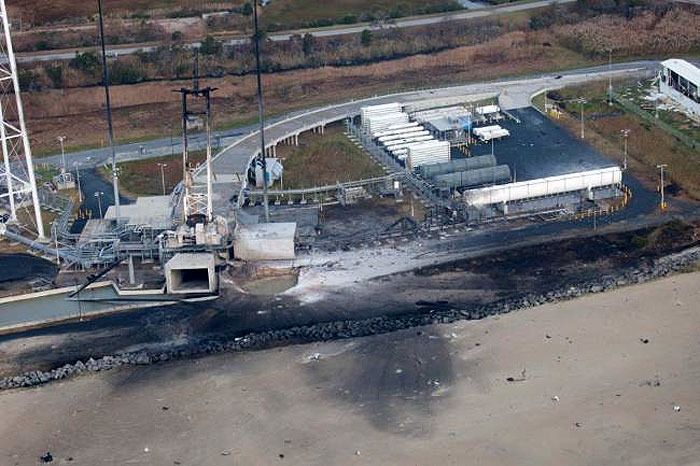.

Damage to Mid-Atlantic Regional Spaceport (MARS) Pad 0A is visible from this aerial photograph taken by NASA on Oct. 29.
.
NORFOLK, Va. -The unmanned rocket that exploded within seconds of launching on Wallops Island will return to space in 2016.
The Virginia Commercial Space Flight Authority announced Tuesday that Antares will undergo a “hot fire” test in 2015 and then head out on its maiden voyage the following year. It was Oct. 28 when the rocket owned by Orbital Sciences Corp. burst into flames just moments after it lifted off for the International Space Station. Initial reports pointed to a failure in one of its two main engines.
No one was hurt in the eruption, and officials said an anomaly in its first stage 15 seconds after taking off caused a catastrophic failure of the vehicle.
Antares was the fifth launch by Orbital and the first failed one. The Mid-Atlantic Regional Spaceport Pad was spared severe damage as the rocket fell just north of the launch mount. The company said everyone at the site had been accounted for after the explosion, and the damage appeared to be limited to the facilities.
Nothing on the lost flight was urgently needed by the six people living on the space station 260 miles into space.
The repairs are estimated to take about 12 months. Initial environmental tests, pumping water from the impact crater and sampling it, have shown no impact to back bays and tributaries. Some soil was contaminated and crews will have to remove six-inches of dirt from the area.
The launch pad damaged in the explosion was $160 million – $90 million coming from Virginia, $60 million from NASA and $10 million from Orbital.
“We are looking for both Orbital and NASA to partner with the Commonwealth for funding to begin repairing the launch facility and ongoing environmental cleanup,” said Aubrey Layne, secretary of transportation.
The Antares rocket was carrying a Cygnus cargo capsule, loaded with 5,000 pounds of gear for the astronauts living on the International Space Station. It was initially scheduled to launch Oct. 27, and Orbital Sciences Corp. got within the 10-minute mark for liftoff, but a sailboat ended up in the restricted danger zone, and controllers halted the evening countdown.
About one-third of the contents of the Cygnus involved science research. Among the instruments that were lost: a meteor tracker and 32 mini research satellites, along with numerous experiments compiled by schoolchildren.
The two Americans, three Russians and one German on the orbiting space station were watching a live video feed from Mission Control and saw the whole thing unfold before their eyes, said NASA’s space station program manager Mike Suffredini. They were keeping abreast of what was happening.
Quelle: WAVY
4443 Views
